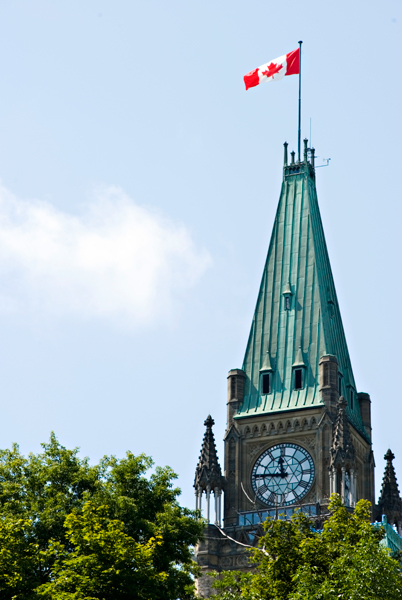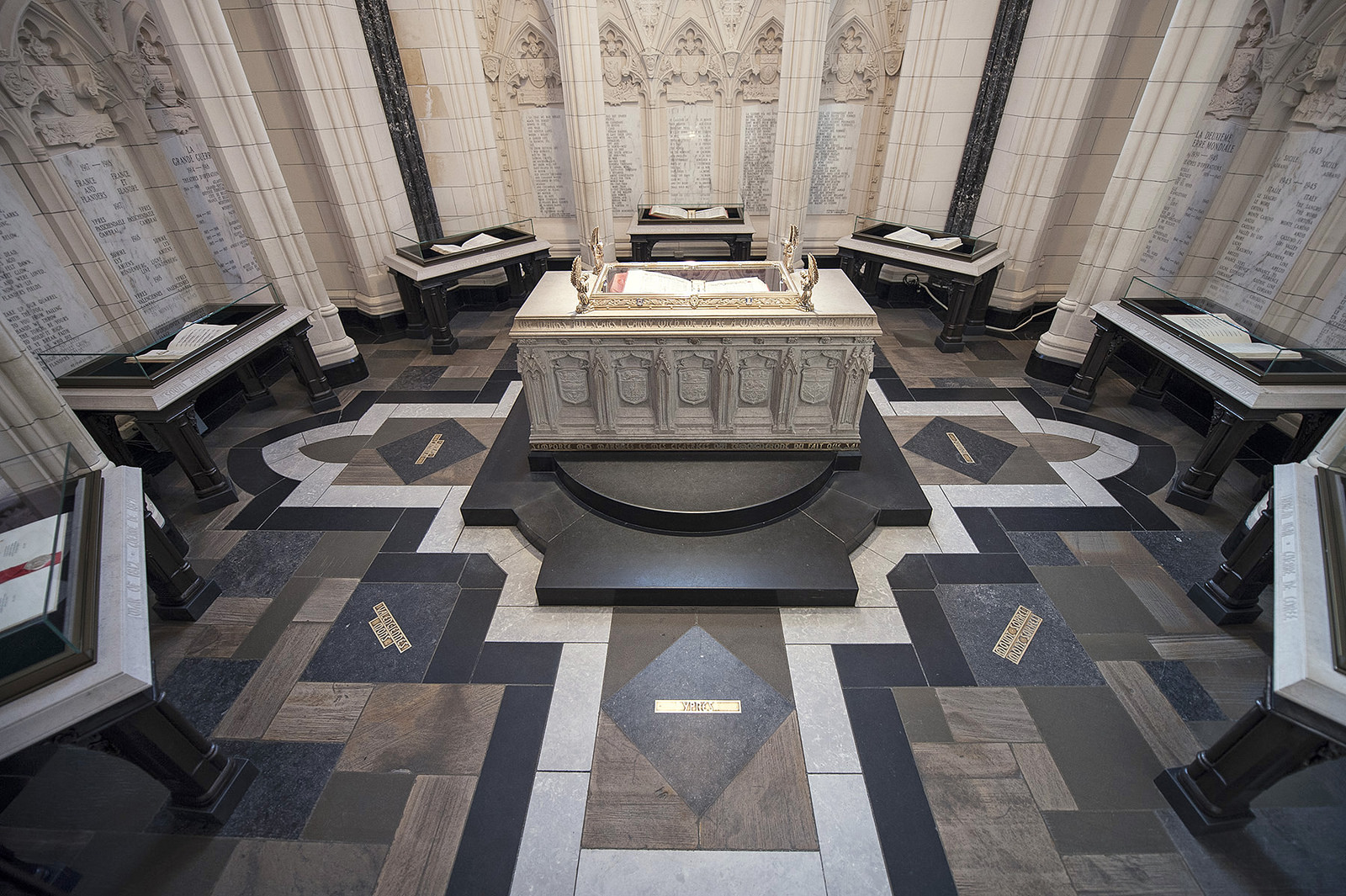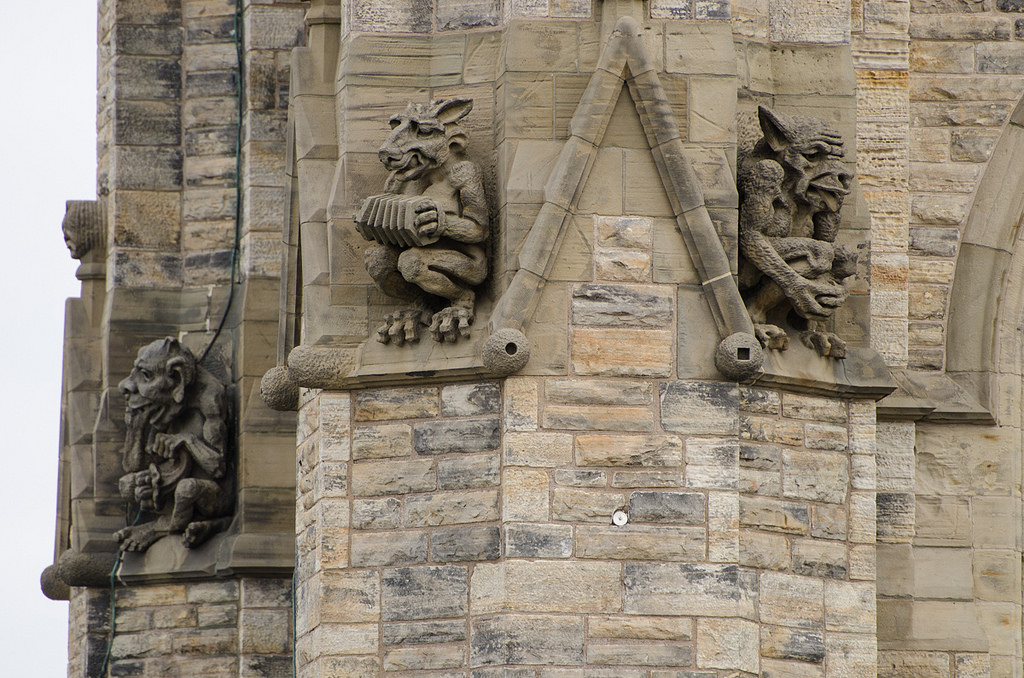Explore the Peace Tower
At a height of nearly 98 metres, the Peace Tower is the dominant feature on Parliament Hill, and probably the most widely recognized symbol of Canada after the flag.
Soar over the Peace Tower
Enjoy the breathtaking aerial images of the Centre Block, the Peace Tower, the grounds of Parliament Hill and the Ottawa River.
Changing of the Peace Tower flag
The Peace Tower flag is changed each day from Monday to Friday and on days when it is flown at half mast. The flag is not changed on statutory holidays or during poor weather.
Learn more about the Parliament Hill flags.
Peace Tower clock
In 1927, the Peace Tower clock was given to Canada by the United Kingdom. The gift marked the 60th anniversary of Canadian Confederation. The original clock no longer works and has since been replaced. However, visitors to the Peace Tower can view it on display in the Tower's observation deck.
There are four clock faces in total: one on each side of the Tower. The hour and minute hands of each face are run by an electric motor. Its controls are located ten storeys down the Tower on the master clock. The precise timing of the clock is kept by the National Research Council's atomic clock in Ottawa.
People are often interested to learn that the Tower's master clock cannot be set back. Therefore, at the end of Daylight Saving Time in autumn, a government employee halts the clock for a full hour overnight. In the spring, the hour hand is moved forward one hour. Its chimes are temporarily disconnected to prevent them from ringing during the process.
Peace Tower carillon
The Peace Tower carillon is one of the oldest and finest carillons in North America. It includes 53 bells and weighs 54 tonnes. These bells range in weight from 10,090 kilograms to only 4.5 kilograms. The bourdon is the largest and heaviest bell and plays the low note E. The smallest and lightest bell plays the A—four and a half octaves higher! The sound you hear each hour is made by the bourdon.
A carillon is played from a large keyboard—similar to an organ. The person who plays the bells is called a carillonneur. Carillonneurs play the bells by striking the keys with their fists. To play the larger bells, they must strike the keys with their feet. The bells do not actually swing. Instead, a clapper strikes each bell with the force that the carillonneur uses to strike the key.
The Peace Tower carillon was developed from the 17th century chiming clocks in Belgium and the Netherlands. Musicians from all over the world come to Ottawa to study this superbly tuned instrument.
Enjoy the carillon concerts and discover a unique musical experience.
Memorial Chamber
The Memorial Chamber is a solemn room near the base of the Peace Tower. Built of marble, the room is dedicated to the Canadians who died in conflicts around the world.
The Chamber's stained glass windows show the journey of soldiers from the call of battle to the return home. The floor is made from stone collected from the battlefields of Europe: Ypres, Sommes, Vimy and Verdun, to name a few.
The Chamber contains a massive stone central altar. The altar is surrounded by seven altars that are made of stone and bronze. Each altar holds a different Book of Remembrance. These books contain the names of the more than 118,000 Canadians who fought and died in the service of Canada.
The Books are displayed open in glass cases. At 11 o'clock every morning, one page is turned in each book during a ceremony. The families and friends of Canada's fallen heroes can search the Books of Remembrance or contact the Memorial Chamber to learn when their loved one's name will be shown.
Learn more about the history of the Memorial Chamber.
The Memorial Chamber altars
To mark the 100th anniversary of the First World War, the six wooden altars in Parliament Hill's Memorial Chamber were replaced by ones made of stone and bronze. As well, to mark the 200th anniversary of the signing of the peace treaty that ended the War of 1812, a new Book of Remembrance and altar were added to the Memorial Chamber.
Watch the video to see the new altars and to hear the story of this sacred place.
Stone carvings
Stone carvings of human and animal figures and ancient creatures stare down from the outer walls of the Peace Tower. Although commonly called gargoyles, these stonework figures are properly referred to by various other names—grotesques, reliefs and bosses—depending on the style in which they are carved.
The types of stone carvings on the Peace Tower are as follows:
- A grotesque is a fanciful human or animal figure that symbolizes the desire to fight the power of evil. Grotesques are characterized by their distorted, absurd or ugly features.
- A relief is any raised sculpture that is carved into a flat panel of material. The Peace Tower contains a number of sandstone panels—called friezes—into which these types of figures are engraved.
- A boss is an ornamental block carving. Bosses made from Wallace and Birmingham Buff sandstones can be found at the ends of mouldings and arches at the Peace Tower.
- A gargoyle is a decorative waterspout or eavestrough that is carved in the form of a human or animal figure. The purpose of gargoyles is to direct rain water away from the building and to ward off evil. There are four such non-functional sculptures, each approximately 2.5 metres long, on the Peace Tower.
More information
- Visit Canada's Parliament—Book a guided tour of the Centre Block, enjoy the 360° view from the Peace Tower and visit the Memorial Chamber
- View the Hill cam


